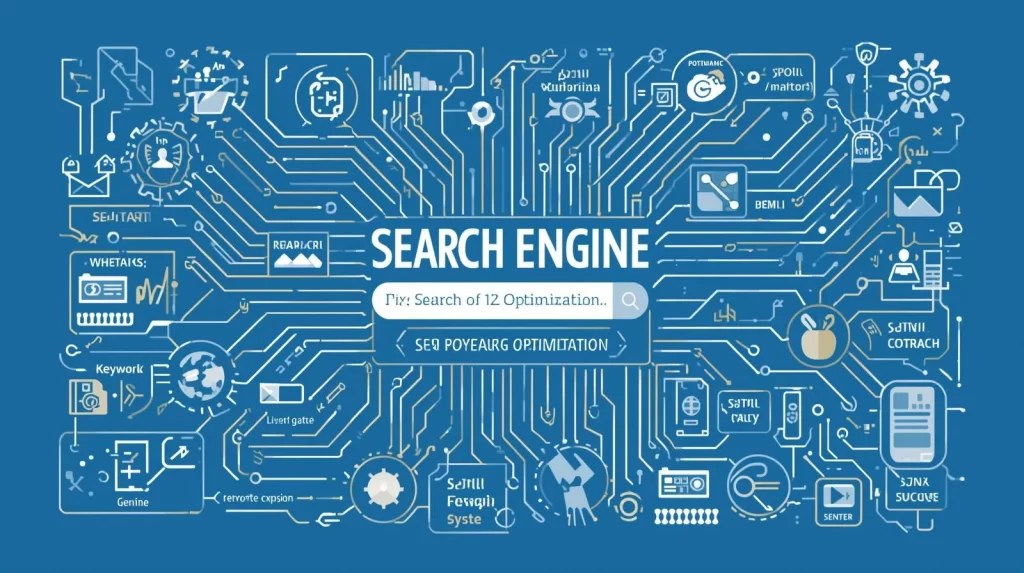Search engine optimization (SEO) is crucial for online visibility. While Google dominates, Bing holds a significant market share. Understanding how SEO works in Bing can unlock new opportunities.
Bing’s algorithm differs from Google’s in several ways. It places more emphasis on on-page factors like title tags and meta descriptions. Social signals also play a larger role in Bing’s rankings.
Optimizing for Bing requires a unique approach. Bing favors explicit, well-structured content that uses natural language. Backlinks are essential, but quality and relevance matter more than quantity.
Bing’s Webmaster Tools offer valuable insights. They provide SEO reports and keyword research tools to help improve your site’s performance. Multimedia optimization is also crucial, as Bing excels in image and video search.
Local SEO is another key area for Bing. Accurate business listings and reviews can boost your local search presence. Bing’s integration with Microsoft products offers unique visibility opportunities.
Understanding Bing’s algorithm can enhance your SEO strategy. By focusing on Bing’s specific ranking factors, you can improve your site’s visibility and reach a broader audience.
Why Optimize for Bing? Market Share, Audience, and Unique Opportunities
Even with Google’s dominance, Bing can’t be ignored. It commands a notable share of the search market, especially in the US. Ignoring Bing could mean missing out on valuable traffic and leads.
Bing attracts a distinct audience. It’s integrated with Microsoft products, like Windows and Xbox, offering access to tech-savvy users. This audience represents diverse demographics, providing niche marketing opportunities.
Optimizing for Bing also presents unique advantages. Fewer sites compete as aggressively as on Google, making achieving high rankings easier. Bing’s transparency about its algorithms offers clearer SEO guidelines.
Moreover, Bing’s ecosystem provides interesting opportunities. It connects with LinkedIn for B2B marketing, tapping into professional networks. Additionally, Bing supports advanced image and video searches, allowing creative content marketing strategies.
Here are key reasons to optimize for Bing:
- Significant US market share
- Integration with Microsoft products
- Less competition compared to Google
- Opportunities in niche and B2B markets
- Advanced multimedia search capabilities
By tapping into Bing’s ecosystem, you can enhance your SEO strategy. You’ll reach new audiences and uncover overlooked opportunities.
How SEO Works in Bing: Core Principles and Ranking Factors
Understanding how SEO functions in Bing is essential for success. Bing values different elements than Google, which affects optimization strategies. Emphasizing on-page factors, Bing places great importance on meta tags and descriptions.
Content clarity and structure are crucial for Bing. It prioritizes well-organized content that uses natural language. This emphasis is evident in Bing’s favoring of exact-match keywords within content.
Backlink quality is another significant factor. While backlinks are essential for both Bing and Google, Bing stresses the relevance and authority of links. This means fewer, but more authoritative, links can be impactful.
Social signals strongly influence Bing’s rankings. Engagement on platforms like Facebook and Twitter can enhance visibility, and Bing’s algorithm considers social media presence a trust signal.
User engagement metrics, such as click-through rates and dwell time, play crucial roles. Bing rewards sites that maintain visitor interest and promote interaction. Creating engaging and informative content is essential.
Here’s a concise summary of Bing’s core ranking factors:
- On-page SEO (titles, meta descriptions)
- Content structure and natural language
- High-quality backlinks
- Strong social signals
- User engagement metrics
Ultimately, understanding these principles aids in forming effective Bing SEO strategies. Following them ensures higher rankings and improved visibility on Bing’s search results.
Bing vs. Google: Key Differences in SEO Approach
While Bing and Google serve similar purposes, their SEO strategies differ considerably. Bing places greater emphasis on on-page SEO elements than Google, including well-crafted title tags and meta descriptions.
Social media influence is another area where Bing and Google diverge. Bing prioritizes social signals more heavily. Engagement and shareability positively impact Bing rankings, making social media activity vital.
Bing also favors exact keyword matches. Its approach is more precise than Google’s, necessitating strategic keyword placement within content.
The list of Bing and Google’s SEO differences includes:
- Greater emphasis on on-page SEO in Bing
- Higher value on social signals by Bing
- Preference for exact-match keywords in Bing
Moreover, Bing’s user interface and search result display differ. Bing often highlights multimedia content, seamlessly integrating images and videos into search results, in contrast to Google’s more text-heavy results.
Machine learning plays a minor role in Bing’s algorithm than Google’s RankBrain. Bing provides more explicit guidance on content quality, presenting unique opportunities for stability and consistency in rankings.
Understanding these differences informs an adaptable SEO strategy. Marketers can effectively target their optimization efforts by recognizing and leveraging Bing’s distinct preferences.
Setting Up for Success: Bing Webmaster Tools and Site Submission
Setting up Bing Webmaster Tools is critical in ensuring your site’s success. This tool offers insights and resources essential for effective Bing SEO. Begin by creating a Bing Webmaster Tools account and verifying your website.
Bing provides several features for site owners. These include SEO reports, keyword research tools, and performance data. Such tools help identify areas for improvement and optimize content for better results.
An important step is submitting your site to Bing. This process ensures Bing can crawl and index your pages efficiently. Submitting an XML sitemap further enhances Bing’s ability to navigate your site structure.
Here’s a simple setup checklist for Bing Webmaster Tools:
- Create an account and verify your website
- Utilize SEO reports and keyword tools
- Submit your site and XML sitemap
Once your site is submitted, monitor its performance regularly. Bing Webmaster Tools provides detailed analytics that highlight visitor behavior and keyword performance. Analyzing this data allows for informed adjustments, maintaining the effectiveness of your SEO strategy.
Using Bing’s tools effectively can set the foundation for continuous growth. This approach is key to achieving consistent visibility in Bing search results.
Keyword Research and On-Page Optimization for Bing
Keyword research is an essential part of Bing’s SEO. It is crucial to identify the right keywords that align with Bing’s search tendencies. Start by leveraging Bing’s keyword research tools, which offer insights unique to this platform.
Focusing on both short-tail and long-tail keywords is vital. Bing tends to prefer more specific phrases that closely match user queries. This specificity can be a competitive advantage when aiming to attract targeted traffic.
Consider the following strategies for effective keyword research:
- Utilize Bing’s keyword tools to identify relevant terms
- Focus on both general and specific keywords
- Include synonyms and related terms to cover variations
After selecting your keywords, the next step is on-page optimization. It’s about strategically placing these terms on your site. Pay attention to title tags and meta descriptions, as Bing values these elements highly.
Ensure that your content is structured logically. Bing appreciates clear and easy-to-navigate content. Use headers and subheaders to break down complex information, making it more digestible.
Here’s a checklist to optimize your on-page content:
- Incorporate keywords in title tags, headers, and throughout the text
- Use meta descriptions effectively, including primary keywords
- Create a logical structure with subheaders and bullet points
Monitor your content’s performance through Bing Webmaster Tools. Checking the performance data helps refine your approach over time. Always look for opportunities to enhance keyword usage and align content with Bing’s preferences.
Improving on-page optimization isn’t a one-time task. Regular updates and adjustments are key. Adapting your strategy based on analytics ensures ongoing success in Bing search rankings.
Exact-Match Keywords and Content Structure
Exact-match keywords hold a unique place in Bing’s SEO landscape. These keywords are crucial as Bing rewards precise matches in search queries. Knowing how to use them effectively can give you an edge.
Implement exact-match keywords strategically across your site. They should appear in key areas like titles and headers where they naturally fit. But always maintain a balance to avoid keyword stuffing.
Here’s a simple method for using exact-match keywords:
- Identify highly relevant exact-match terms for your niche
- Integrate them into titles, headers, and introductory paragraphs
- Ensure natural placement without compromising readability
Content structure is equally essential in Bing SEO. A well-organized page makes it easier for Bing to crawl and index. Use clear headings and subheadings to segment your content logically.
Creating this structure also enhances the user experience. Readers are more likely to engage with easy-to-follow content, which positively affects user metrics. These metrics can, in turn, influence your rankings on Bing.
A logical content structure and strategic exact-match keyword use maximize your SEO potential. These practices ensure that both search engines and users understand your content’s purpose and value.
Technical SEO for Bing: Site Structure, Speed, and Mobile Optimization
Technical SEO is a cornerstone of optimizing your site for Bing. Your site’s structure plays a vital role in helping Bing understand your content. A well-organized site with clear navigation aids in better indexing and ranking.
Ensure that your URLs are clean and descriptive. Bing prefers URLs that include keywords, offering clear context about the page. A logical URL structure assists in further optimizing the site.
Site speed is another crucial factor. Bing values fast-loading websites because they enhance the user experience. Use tools to check and improve your site’s loading times, reducing delays as much as possible.
Here are some tips for improving site speed:
- Optimize images to reduce their size without losing quality
- Use browser caching to improve load times for returning visitors
- Minimize HTTP requests to speed up page loading
Mobile optimization cannot be overlooked. As mobile search continues to grow, Bing favors mobile-friendly sites. Your site should be responsive, adjusting seamlessly to different screen sizes for optimal viewing on mobile devices.
Check your site’s mobile responsiveness using Bing’s mobile-friendly test tools. This step ensures that all elements appear correctly on smartphones and tablets. A mobile-friendly design boosts engagement rates, which can positively affect your Bing rankings.
Focusing on site structure, speed, and mobile optimization enhances search engine understanding and user satisfaction. These factors are interlinked and significantly impact your visibility on Bing. Keeping these elements in check ensures ongoing success and improved ranking.
Building Authority: Backlinks, Domain Age, and Trust Signals
Building authority is crucial for SEO, and Bing heavily emphasizes it. Backlinks, domain age, and trust signals are key elements that contribute to your site’s authority in Bing’s eyes.
Backlinks are like votes of confidence. However, not all backlinks are created equal. Bing prioritizes the quality and relevance of the links pointing to your site over sheer quantity. A few authoritative backlinks can outweigh a plethora of low-quality ones.
You should acquire backlinks from trusted and relevant sources. Consider reaching out to industry leaders or engaging in partnerships. Guest blogging on popular sites within your niche can boost your backlink profile.
Domain age and authority influence Bing’s ranking algorithm. Older domains with a consistent track record often appear more credible. If starting from scratch, build a strong brand presence over time.
Trust signals play a role in how Bing perceives your site’s reliability. Having clear privacy policies, displaying contact information, and ensuring a secure HTTPS protocol can foster trustworthiness.
Some additional trust-building practices include:
- Using consistent branding across all platforms
- Providing accurate, updated content that aligns with user needs
- Engaging with user feedback and reviews
In essence, building authority for Bing involves earning valuable backlinks, maintaining a reputable domain history, and offering transparent, user-focused experiences. By prioritizing these aspects, you can enhance your site’s credibility and visibility on Bing.
Leveraging Social Media and User Engagement for Bing Rankings
Social media signals are more important in Bing’s algorithm than they are in Google’s. Engaging with your audience on social platforms can influence your Bing SEO.
Bing recognizes popular content with high social engagement, like shares and likes. Promoting your website content across social channels can increase its reach and potential Bing rankings.
User engagement metrics, such as click-through rate and dwell time, are crucial. Bing values how users interact with your content. Users spending more time on your pages signal quality and relevance, which Bing rewards.
Here are some strategies to boost social media and user engagement:
- Share valuable content regularly on social media platforms.
- Encourage users to interact and leave feedback on your site.
- Cultivate an engaging and interactive community.
By focusing on social signals and enhancing user engagement, you can improve your Bing SEO and grow your online presence organically. This approach ensures a balanced strategy that benefits search engine rankings and overall audience growth.
Multimedia SEO: Optimizing Images, Videos, and Rich Content for Bing
Optimizing multimedia content is essential for Bing SEO. Bing’s search results often prominently feature images, videos, and other rich media.
High-quality images with descriptive alt text can enhance how Bing understands and ranks your content. Always use alt attributes to describe your images accurately.
Videos also require optimization. Video sitemaps and proper metadata help Bing index and display video content more effectively.
Here are tips for multimedia SEO:
- Use descriptive file names and alt text for images.
- Ensure videos have engaging thumbnails and explicit metadata.
- Incorporate captions and transcripts for video content.
Focusing on multimedia SEO exploits Bing’s advanced search capabilities for images and videos. This approach helps improve visibility and caters to varied user preferences and browsing habits. Remember, rich content is as important as text for SEO, offering multiple avenues for engagement and ranking opportunities.
Local SEO on Bing: Bing Places, Reviews, and Local Listings
Local SEO is crucial for businesses targeting specific geographic areas. Bing Places for Business plays a key role in improving local visibility.
Registering your business ensures your information is accurate and accessible. Bing integrates local listings with Yelp reviews, highlighting the importance of maintaining positive feedback.
Optimizing for local search involves more than just setting up a Bing Places account. It requires consistent information across all platforms, enhancing user trust.
Key strategies for local SEO on Bing include:
- Complete and verify your Bing Places listing.
- Manage and respond to customer reviews effectively.
- Ensure consistency in business information across platforms.
These steps help Bing deliver relevant local results, connecting users with needed services. Taking a proactive approach improves your local search presence and builds credibility and customer trust. Bing’s algorithm values accurate and up-to-date information, so staying consistent across different channels is essential for local SEO success.
Advanced Bing SEO: Structured Data, Voice Search, and Emerging Trends
Bing is steadily evolving, bringing new SEO trends into the spotlight. One of these trends is structured data, which enhances search results through rich snippets. Implementing schema markup helps Bing understand your content better, improving visibility.
Voice search is another growing area. Bing’s integration with Microsoft’s digital assistant, Cortana, underscores the importance of optimizing for natural language queries. Ensuring your content answers common questions succinctly can boost voice search rankings.
As technology advances, so do user expectations. Staying ahead of emerging trends ensures your strategy remains effective and competitive.
Key emerging trends to focus on include:
- Utilizing structured data for enhanced snippets.
- Optimizing for voice search with natural language.
- Monitoring and adapting to algorithm updates.
Focusing on these advanced techniques can leverage Bing’s unique capabilities. These trends enhance search visibility and prepare your site for future developments. Staying informed and adaptable is essential for mastering Bing SEO in a dynamic digital landscape.
Monitoring, Analytics, and Continuous Improvement with Bing Tools
Utilizing Bing’s robust analytics tools is vital for SEO success. Bing Webmaster Tools provides insight into your site’s performance and user behavior, helping refine your strategies. Regular monitoring ensures you remain informed about search trends and ranking position shifts.
Analytics provide data on queries, click-through rates, and traffic sources. This information is crucial in identifying what works and where adjustments are needed. Analyzing these metrics allows you to tailor your content to meet audience expectations better.
Continuous improvement is key to maintaining SEO efficacy. Update content regularly based on analytics insights, promptly addressing user needs. This proactive approach fosters long-term success in Bing search results.
To make the most of Bing’s analytics tools, focus on:
- Regularly reviewing performance metrics.
- Identifying trends and user behavior patterns.
- Implementing data-driven improvements to content and strategy.
Adopting a cycle of monitoring and improvement helps maintain a competitive edge. Bing’s tools equip you with the necessary insights to adapt, optimize, and succeed. Embrace this analytical approach to refine your presence continuously.
Common Bing SEO Challenges and How to Overcome Them
SEO for Bing presents unique challenges that require specific strategies to overcome. One common issue is adjusting to Bing’s more traditional algorithms, which differ from Google’s AI-driven approach. This demands an emphasis on exact-match keywords and structured data.
Another challenge is integrating multimedia content. Bing often includes more videos and images in its search results. Ensuring multimedia optimization through proper metadata and sitemaps can improve visibility in these rich results.
Additionally, Bing’s reliance on social signals can be a hurdle for those unaccustomed to prioritizing social media. Engaging with your audience on platforms like LinkedIn can enhance your Bing rankings.
Some practical strategies to tackle these challenges include:
- Prioritizing exact-match keywords in your content.
- Optimizing multimedia with detailed sitemaps.
- Enhancing social media presence and engagement.
Understanding these challenges and applying targeted solutions can improve your site’s performance on Bing. Mastering these aspects will ensure a more successful and sustainable Bing SEO strategy.
Bing SEO Checklist: Actionable Steps for Success
Successfully optimizing for Bing requires a focused strategy. A checklist of actionable steps can simplify the process. Regularly following these steps will ensure your content remains competitive in Bing’s search results.
Here’s a checklist for Bing SEO success:
- Set up Bing Webmaster Tools for insights and tracking.
- Use exact-match keywords in titles and headings.
- Enhance site speed and ensure mobile optimization.
- Create and submit detailed sitemaps for multimedia content.
- Engage with audiences on social media for social signals.
- Ensure accurate local listings with Bing Places.
Implementing these steps will help you capitalize on Bing’s unique ranking factors. You can maximize your visibility and influence on Bing by staying organized and proactive. Regular reviews and adjustments based on performance will further support your SEO efforts.
Conclusion: Maximizing Your Visibility with Bing Search Optimization
Bing SEO is different yet offers opportunities to boost search visibility. Understanding its unique principles is key. By focusing on Bing-specific strategies, you align your content with its ranking factors, offering a competitive edge.
Incorporate relevant keywords, optimize for mobile, and engage on social platforms. Use Bing Webmaster Tools for insights. These steps ensure your content reaches the right audience. Continuous refinement will maintain your position in search results. Stay informed of Bing updates for sustained success.
1. Is Bing SEO different from Google SEO?
Yes. While both reward high-quality content, Bing relies more on on-page optimization, keyword relevance, and social signals than Google does.
2. Does Bing care about backlinks?
Absolutely. Bing prefers backlinks from authoritative and relevant domains but does not reward spammy or low-quality links.
3. How can I submit my site to Bing?
You can use Bing Webmaster Tools to submit your sitemap, track performance, and identify indexing issues.
4. Are social media signals important for Bing rankings?
Yes. Unlike Google, Bing uses social engagement as a direct ranking factor. Strong social presence can improve visibility.
5. What type of content performs best on Bing?
Well-structured, keyword-optimized, and authoritative content with multimedia (images, videos) tends to perform better.
Optimizing for Bing can open up new opportunities to reach audiences many brands overlook. By focusing on keyword accuracy, authoritative backlinks, and active social engagement, your website can achieve strong visibility on Bing’s search results.
Partner with a trusted digital marketing company like ours to boost your rankings across all major search engines. We specialize in tailored SEO strategies that enhance visibility, drive organic traffic, and deliver measurable results.
Read More






